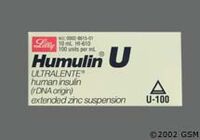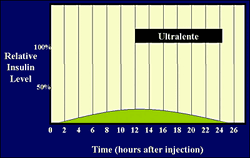m (→Combining Lente Family Insulins: adding duration & link) |
(adding info & ref re: people who absorb UL quickly) |
||
| Line 3: | Line 3: | ||
Ultralente is not used very successfully in dogs, but has been widely used in treatment of cats. With an [[onset]] of 1-4 hours and a [[duration]] of 12-24 hours. Most cats require 2 ultralente shots a day. Ultralente [[absorption]] can be erratic, with about 20% not responding to the insulin--not even with twice-daily dosing<ref>[http://petdiabetes.wikia.com/images/d/d5/Providing_care_veterinary_diabetics.pdf Providing Care for Diabetic Veterinary Patients-International Journal of Pharmaceutical Compounding-2000-Page 3]</ref>.[[Image:Ultratardhm.png|thumb|200px|right|Novo Nordisk Ultratard HM-GE Human Ultralente insulin.]]<br><br> |
Ultralente is not used very successfully in dogs, but has been widely used in treatment of cats. With an [[onset]] of 1-4 hours and a [[duration]] of 12-24 hours. Most cats require 2 ultralente shots a day. Ultralente [[absorption]] can be erratic, with about 20% not responding to the insulin--not even with twice-daily dosing<ref>[http://petdiabetes.wikia.com/images/d/d5/Providing_care_veterinary_diabetics.pdf Providing Care for Diabetic Veterinary Patients-International Journal of Pharmaceutical Compounding-2000-Page 3]</ref>.[[Image:Ultratardhm.png|thumb|200px|right|Novo Nordisk Ultratard HM-GE Human Ultralente insulin.]]<br><br> |
||
| − | Ultralente insulin is not very reliable when used with many people, either. This is why it wasn't widely used enough to remain on either [[Eli Lilly]]'s or [[Novo Nordisk]]'s product list. There's great variability from patient to patient with this insulin<ref>[http://www.ncbi.nlm.nih.gov/entrez/query.fcgi?cmd=Retrieve&db=PubMed&list_uids=11003253&dopt=Abstract Scandanavian Journal of Clinical/Laboratory Investigations-Use of Human Ultralente Limited By Great Intraindividual Variability]</ref>. Conclusion in this abstract is it has far too much day-to-day variability to be truly useful for many. Personally know people who were having night hypos requiring emergency services regularly while using it. Most humans not using an [[analog]] intermediate or long acting insulin for [[basal]] needs are or were using either [[NPH]] or [[Lente]] on an average of twice a day. |
+ | Ultralente insulin is not very reliable when used with many people, either. This is why it wasn't widely used enough to remain on either [[Eli Lilly]]'s or [[Novo Nordisk]]'s product list. There's great variability from patient to patient with this insulin<ref>[http://www.ncbi.nlm.nih.gov/entrez/query.fcgi?cmd=Retrieve&db=PubMed&list_uids=11003253&dopt=Abstract Scandanavian Journal of Clinical/Laboratory Investigations-Use of Human Ultralente Limited By Great Intraindividual Variability]</ref>. Conclusion in this abstract is it has far too much day-to-day variability to be truly useful for many. Some people [[absorption|absorb]] it at a faster than usual rate, so for them it would have only the [[duration]] of an [[:Category:intermediate-acting|intermediate acting]] insulin.<ref>[http://www.diabetes.org/uedocuments/rg06_insulin.pdf Diabetes Forecast-ADA, 2006-Page 2]</ref>. Personally know people who were having night hypos requiring emergency services regularly while using it. Most humans not using an [[analog]] intermediate or long acting insulin for [[basal]] needs are or were using either [[NPH]] or [[Lente]] on an average of twice a day. |
==Specifications of ultralente== |
==Specifications of ultralente== |
||
Revision as of 15:42, 12 November 2006

Humulin U
Ultralente insulin crystals are large and slowly absorbed because of their size, making this a long-acting insulin. At one time, this type of insulin was also produced in bovine, porcine and mixed bovine-porcine forms. The two who most recently took their last bows are of r-DNA/GE/GM origin.
Ultralente is not used very successfully in dogs, but has been widely used in treatment of cats. With an onset of 1-4 hours and a duration of 12-24 hours. Most cats require 2 ultralente shots a day. Ultralente absorption can be erratic, with about 20% not responding to the insulin--not even with twice-daily dosing[1].

Novo Nordisk Ultratard HM-GE Human Ultralente insulin.
Ultralente insulin is not very reliable when used with many people, either. This is why it wasn't widely used enough to remain on either Eli Lilly's or Novo Nordisk's product list. There's great variability from patient to patient with this insulin[2]. Conclusion in this abstract is it has far too much day-to-day variability to be truly useful for many. Some people absorb it at a faster than usual rate, so for them it would have only the duration of an intermediate acting insulin.[3]. Personally know people who were having night hypos requiring emergency services regularly while using it. Most humans not using an analog intermediate or long acting insulin for basal needs are or were using either NPH or Lente on an average of twice a day.
Specifications of ultralente
British National Formulary[4] defines Ultralente-type insulins as: A sterile neutral (neutral used here refers to the pH, not to the fast-acting insulin known as neutral or R) suspension of bovine insulin or of human insulin in the form of a complex obtained by the addition of a suitable zinc salt; consists of rhombohedral crystals (10-40 microns).
British Pharmacoepia (BP) and United States Pharmacoepia (USP)'s definitions of ultralente insulin:[5]
Insulin zinc suspension (crystalline) BP
Sterile buffered suspension of bovine insulin to which zinc chloride is added. Crystalline form is insoluble in water. Prepared from crystalline insulin containing not more than 23 units/mg. White or almost colourless suspension. Particles are mainly crystalline. Majority of crystals having a maximum diameter greater than 10 m.pH 6.9 - 7.5 Iso-osmotic with blood. Preparation contains 40 and 80 units/ml.
(Note--the BP definition should actually read "mammalian", not "bovine". Novo Nordisk's Ultratard and Eli Lilly's Humulin Zn were both r-DNA/GE/GM insulins. Both were available until recently. Both were also U100 strength, so this strength should have been added above.)
U.S.P. - Sterile suspension of insulin contain 40, 80, 100 units/ml. Contains sodium acetate, sodium chloride and methyl hydroxybenzoate (Concentration same as for amorphous insulin) and zinc 120 - 250 ug. pH 7.2 - 7.5.
What Ultralente Is Not

Human time activity profile for r-DNA/GE/GM ultralente insulin.
No Lente-type insulin regardless of species can contain any NPH/isophane insulin[6] or any R/Neutral insulin[7][8].
Both are chemically impossible: the phenol preservative present in NPH/isophane alters the action of Lente-type insulins, creating a mixture with an approximate action of R/Neutral.
The zinc suspension of Lente-type insulin binds R/Neutral, causing the short-acting insulin to slow, losing its short-acting effect.
Combining Lente Family Insulins
None of the Lente family of insulins (semilente, Lente, Ultralente) can be combined with[9] NPH/isophane insulins. The phenol preservatives present in NPH-type insulins alters the Lente-types to the point where they become a close approximation of R/neutral, with regard to action.
Keeping the phenol preservatives in mind, all protamine-suspended insulin mixes would be "off limits" regarding same syringe mixing with any Lente-type insulins.
Insulin manufacturers[10] indicate that R/neutral and semilente, Lente, ultralente insulins are able to be combined in the same syringe, but only just before injection. In pre-filled syringes, the zinc suspension of the Lente-type insulins binds the R/neutral, causing it to lose its short-acting effect. Various studies have documented this, and some doctors advise against using R/neutral in the same syringe with the Lente family of insulins[11][12][13].
Trade names:
|
Ultralente Insulins | |
|---|---|
| Humulin U, Humulin Zn (No longer produced.) | |
| Novolin U, Ultratard (No longer produced.) | |
Further Reading
References
- ↑ Providing Care for Diabetic Veterinary Patients-International Journal of Pharmaceutical Compounding-2000-Page 3
- ↑ Scandanavian Journal of Clinical/Laboratory Investigations-Use of Human Ultralente Limited By Great Intraindividual Variability
- ↑ Diabetes Forecast-ADA, 2006-Page 2
- ↑ British National Formulary-Ultralente Definition
- ↑ British Pharmacoepia (BP) and United States Pharmacoepia (USP) Definitions of Ultralente Insulin
- ↑ Combining Lente-type Insulins with Phenol-Preserved Insulins
- ↑ Lente Zinc Suspension Causes Loss Of R/Neutral Short-Acting Effect
- ↑ Availability of Soluble (R/Neutral) Insulin in Mixed Preparations of Crystalline (Lente) & Ultralente GE Insulins-Clinical Therapeutics-1991
- ↑ Phenol Preservatives & Lente-type Insulins--A Bad Combination
- ↑ Insulin Producers vs Doctors Re:Combining R/Neutral & Lente-type Insulins
- ↑ Availability of Soluble (R/Neutral) Insulin in Mixed Preparations of Crystalline (Lente) & Ultralente GE Insulins-Clinical Therapeutics-1991
- ↑ Absorption Kinetics & Action Profiles-Single Subcutaneous Administration of Human Soluble (R/Neutral) & Lente Insulin-Diabetes Care-1987
- ↑ Delayed Onset of Action of Soluble (R/Neutral) Insulin After Premixing With Lente Insulin Diabetes Research & Clinical Practice-1983